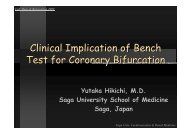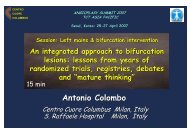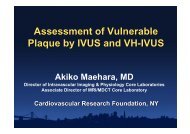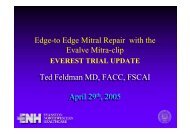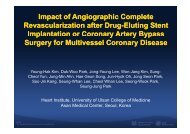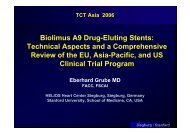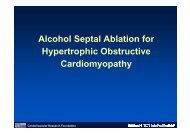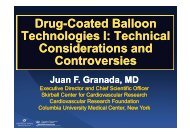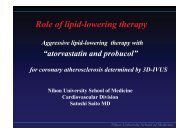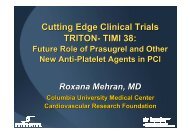Alaide Chieffo and Antonio Colombo - summitMD.com
Alaide Chieffo and Antonio Colombo - summitMD.com
Alaide Chieffo and Antonio Colombo - summitMD.com
Create successful ePaper yourself
Turn your PDF publications into a flip-book with our unique Google optimized e-Paper software.
ANGIOPLASY SUMMIT 2009<br />
TCT ASIA PACIFIC<br />
Seoul, Korea: 22-24 April 2009<br />
Left Main <strong>and</strong> Bifurcation Summit<br />
Debate: treating side branch-planned<br />
use of side branch stenting for all<br />
bifurcations<br />
Speaker – 15’<br />
<strong>Alaide</strong> <strong>Chieffo</strong> <strong>and</strong> <strong>Antonio</strong> <strong>Colombo</strong><br />
S. Raffaele Hospital Milan, Italy<br />
Centro Cuore Columbus Milan, Italy
Approach to Bifurcational Lesions Including LM<br />
The bifurcation is a True Bifurcation<br />
(significant stenosis on the MB <strong>and</strong> SB)<br />
No<br />
Yes<br />
Provisional SB stenting, KIO<br />
No<br />
The SB is suitable for stenting<br />
Yes<br />
Stent on MB, PTCA on the side<br />
branch<br />
No<br />
The disease on the SB extends for more than 3<br />
mm from the ostium of the side branch:<br />
Yes<br />
Provisional SB stenting<br />
Elective implantation of two<br />
stents (MB <strong>and</strong> SB)
Bifurcations<br />
1.Provisional<br />
2.Two<br />
Stents<br />
3.Keep<br />
It Open (KIO)
Bifurcations<br />
Two Stents<br />
When the SB has disease extending beyond its<br />
ostium AND when the SB is suitable for stenting<br />
8 Fr guiding catheter<br />
1. Wire both branches<br />
2. Dilate MB <strong>and</strong> SB if needed<br />
3. Perform crush or V-stent<br />
4. If crush: rewire SB <strong>and</strong> perform high pressure<br />
SB dilatation<br />
5. Kissing balloon inflation
CACTUS trial<br />
Coronary Bifurcation Application of the Crush<br />
Technique<br />
Using<br />
Sirolimus-Eluting<br />
stents<br />
Study Design <strong>and</strong> Time Frame<br />
n = 350 patients<br />
TRUE<br />
de de novo TRUE<br />
bifurcation lesions<br />
of of the the native<br />
coronary arteries<br />
R<br />
Crush<br />
CYPHER SELECT<br />
n = 1771<br />
Pre-dilatatio<br />
dilatation<br />
1<br />
month<br />
Clinic.<br />
F/U<br />
6 month<br />
Angio.<br />
F/U<br />
12, 12, 18, 18, 24<br />
24<br />
month<br />
Clinical F/U<br />
R = r<strong>and</strong>omization<br />
Provisional T<br />
CYPHER SELECT<br />
n = 1731<br />
Dual antiplatelet therapy was re<strong>com</strong>mended in all pts for at least 6 months
CACTUS trial<br />
Coronary Bifurcation Application of the Crush<br />
Technique<br />
Using<br />
Sirolimus-Eluting<br />
stents<br />
6-month in-segment binary restenosis<br />
Angiographic F.U. performed in 86% of pts in both groups<br />
20<br />
Crush (n=177)<br />
Prov.-T (n=173)<br />
15<br />
13.2 14.7<br />
%<br />
10<br />
5<br />
0<br />
4.6<br />
N<br />
7/152<br />
6.7<br />
N<br />
10/150<br />
N<br />
20/152<br />
N<br />
22/150<br />
MB<br />
(main branch)<br />
SB<br />
(side branch)
CACTUS trial<br />
Coronary Bifurcation Application of the Crush<br />
Technique<br />
Using<br />
Sirolimus-Eluting<br />
stents<br />
Stent thrombosis<br />
Total<br />
Acute<br />
Subacute<br />
Late<br />
(first day)<br />
(days 2-30)<br />
(days 31-180)<br />
Crush<br />
(n=177)<br />
Prov.T<br />
(n=173)<br />
3 (1.7%) 1 (0.5%) 2* (1.1%) 0<br />
2 (1.1%) 0 1 (0.5%) 1 (0.5%)<br />
(definitive)<br />
p = 0.62 for <strong>com</strong>parisons between crush <strong>and</strong> prov.-T<br />
* One patient did not take thienopyridine therapy after discharge
Provisional could be Ok<br />
2 Stents better
A Typical Case for 2 stents<br />
Baseline<br />
Following Crush<br />
Crush<br />
12472/05
Mini-Crush Case1<br />
Baseline<br />
Min12870
Mini-Crush Case1<br />
Pre-dilatation<br />
Min12870
Mini-Crush Case1<br />
Result after pre-dilatation<br />
Min12870
Mini-Crush Case1<br />
Xience 2.5x18mm<br />
Promus 3.0x28mm<br />
Mini-Crush<br />
Min12870
Mini-Crush Case1<br />
Promus 3.0x28mm<br />
Stent on LAD<br />
Min12870
Mini-Crush Case1<br />
After Stent on LAD<br />
Min12870
Mini-Crush Case1<br />
2 Quantum<br />
3.0 x15 mm 28 Atm<br />
Kissing Balloon<br />
Min12870
Mini-Crush Case1<br />
Result post Kissing<br />
Min12870
Mini-Crush Case1<br />
Promus 2.5x28mm<br />
Distal Stent<br />
Min12870
We observed that two-step kissing was more effective<br />
than one-step kissing for improving metallic sidebranch<br />
ostial area<br />
No kissing<br />
One-step kissing<br />
post-dilatation<br />
Two-step<br />
kissing postdilatation<br />
SB ostial stenosis (%) with one step<br />
vs. two step kissing<br />
58 crush deployments<br />
Two steps:<br />
1)Inflate at high pressure<br />
only the SB balloon<br />
2)Perform kissing inflation<br />
Ormiston
2 case. IVUS-Guided<br />
Stent Bifurcation<br />
Baseline<br />
12786/07
IVUS-Guided<br />
Stent Bifurcation<br />
Diag: Xience 2.5x18mm 14atm<br />
LAD: Xience 3.5x18mm 18atm<br />
Stents in<br />
bifurcation<br />
Result after stent<br />
12786/07
Ostial diagonal<br />
distal stent diag<br />
3.0mm<br />
Stent area :4.6mm 2<br />
distal diag ref<br />
Bifurcation<br />
LAD<br />
IVUS-Guided<br />
Stent<br />
Bifurcation<br />
Result after stent<br />
12786/07
IVUS-Guided<br />
Stent Bifurcation<br />
Ostial diagonal<br />
3.0 mm<br />
Stent area :4.6mm 2<br />
More can be done<br />
Suggested 3.0 mm balloon for<br />
diagonal post-dilatation<br />
<strong>and</strong> agreed on 2.5mm very<br />
high pressure<br />
Result after stent<br />
12786/07
IVUS-Guided<br />
Stent Bifurcation<br />
LAD : 3.5mmx28atm<br />
Diag : 2.5mmx26atm<br />
High-pressure<br />
dilatation<br />
Result post high-pressure<br />
dilatation<br />
12786/07
IVUS-Guided<br />
Stent Bifurcation<br />
Result post high-pressure dilatation<br />
ostial diag<br />
3.3mm<br />
Bifurcation<br />
Stent area :5.0mm 2<br />
60% 3.0 = 4.24mm 2<br />
Distal LAD<br />
Distal LAD Refer<br />
12786/07
IVUS-Guided<br />
Stent Bifurcation<br />
Final Result<br />
12786/07
IVUS-Guided<br />
Stent Bifurcation<br />
9 months Follow-Up<br />
12786/07
3 case Distal LM
IVUS Images Post Rotablator<br />
LAD Os<br />
Cx Os
• Crush technique: 3.0x33 Cypher in Cx <strong>and</strong> 3.5x18 Cypher in LAD.
Final result after kissing<br />
No restenosis at FU
29072008 CCC
Nordic 6 months MACE<br />
MACE in 2 stents 3.4%<br />
MACE in 1 stent 2.9%<br />
Peri procedural MI not included in the MACE<br />
Steigen et al. Circulation 2006;114:1955-1961
NORDIC Bifurcation Study<br />
Individual End Points after 6 months<br />
1 Stent<br />
2 Stents<br />
P<br />
Patients 207 206<br />
Cardiac death 2 (1.0) 2 (1.0) 1.00<br />
Myocardial infarction 0 (0.0) 1 (0.5) 0.31<br />
Stent thrombosis 1 (0.5) 0 (0.0) 0.31<br />
Steigen et al Circulation 2006
NORDIC Bif Study EuroInterv.2008;4:229-233
Nordic Bifurcation Study<br />
Clinical endpoints after 14 months<br />
MV<br />
MV + SB<br />
Definite stent thrombosis, n (%) 2/199 (1.0) 1/196 (0.5) ns<br />
Probable stent thrombosis, n (%) 2/199 (1.0) 0/196 (0) ns<br />
Possible stent thrombosis, n (%) 1/199 (0.5) 0/196 (0) ns<br />
Overall stent thrombosis, n (%) 4/199 (2.0)° 1/199 (0.5) ns<br />
Total death, n (%) 5/207 (2.4) 2/206 (1.0) ns<br />
Cardiac death, n (%) 3/207 (1.4) 2/206 (1.0) ns<br />
Myocardial infarction, n (%) 4/199 (2.0) 2/196 (1.0) ns<br />
Target lesion revascularisation, n (%) 13/199 (6.5) 11/196 (5.6) ns<br />
Target vessel revascularisation, n (%) 15/199 (7.5) 12/196 (6.1) ns<br />
MACE, n (%) 19/199 (9.5) 16/196 (8.2) ns<br />
*One patient experienced a definite stent thrombosis <strong>and</strong> was treated with balloon angioplasty. The<br />
same patient died suddenly ten days later <strong>and</strong> the event was classified as a possible stent thrombosis.<br />
NORDIC Bif Study EuroInterv.2008;4:229-233<br />
233<br />
P
Nordic II: Rate of Restenosis (≥50%(<br />
diameter stenosis by QCA) at 8M<br />
In-segment<br />
In-stent
Nordic II: Localization of In-Stent<br />
Restenosis<br />
at 8 Months<br />
Follow-up<br />
CRUSH<br />
CULOTTE<br />
0.0%<br />
0.0%<br />
9.8%*<br />
2.0% 0.6%<br />
3.8%*<br />
* p=0.04
MACCE at 12 Months: SYNTAX pts non LM<br />
PCI Bifurcation/Trifurcation Subset (Non LM)<br />
>2 Stents (n=67) n=67)<br />
1 Stent (n=118)<br />
30<br />
25<br />
P=0.17 P=0.42 P=0.53 Undef P=0.24 P=1.00<br />
22,2<br />
20<br />
15<br />
13,8<br />
15,4<br />
10<br />
5<br />
0<br />
9,2<br />
7,7<br />
5,1 5,1<br />
4,5<br />
3,2<br />
1,5<br />
0,0 0,0<br />
MACCE All death MI CVA Revasc ST<br />
ST=Per-protocol stent thrombosis
Conclusions<br />
A)Bifurcations without SB ostial disease are usually<br />
successfully treated with one stent on the MB <strong>and</strong> kissing<br />
balloon inflation toward the side branch<br />
B)Bifurcation with significant narrowing at the ostium of<br />
the SB are treated as in (A) with the need of a stent on the<br />
in 1/3 of the cases (miniCrush, culotte or T)<br />
C) Bifurcation with a large SB <strong>and</strong> with disease extending<br />
more than 3-4 mm from the ostium are treated with<br />
2 stents<br />
If you need 2 stents implant 2 stents



